An asthma action plan for adults guides you to recognize triggers and symptoms early, like wheezing or chest tightness. It emphasizes monitoring your lung function with peak flow readings and sticking to your medication schedule for long-term control. Knowing when to seek help is essential, especially if symptoms worsen or become severe. Clear communication with family and regular updates to your plan help prevent emergencies. Keep reading to learn more about managing your asthma effectively.
Key Takeaways
- Recognize asthma triggers and early warning signs to prevent attacks.
- Regularly monitor lung function using peak flow measurements and track patterns.
- Develop a tailored medication and action plan based on symptom severity.
- Know emergency steps, including when to seek urgent medical help.
- Communicate and review the asthma plan regularly with healthcare providers and caregivers.
Understanding Your Asthma Triggers and Symptoms

Understanding what triggers your asthma and recognizing your symptoms are essential steps in managing the condition effectively. You need to identify specific things that cause your asthma flare-ups, such as allergens, smoke, exercise, or cold air. Pay attention to your body’s signals—wheezing, shortness of breath, chest tightness, or coughing—that indicate an asthma episode is starting. Keeping track of these symptoms helps you anticipate when your asthma worsens. By understanding your triggers and symptoms, you can take proactive steps to avoid or minimize exposure. This awareness allows you to act quickly when symptoms appear, preventing severe attacks and keeping your asthma under control. Recognizing your unique triggers empowers you to live more comfortably and confidently. Additionally, understanding your inhaler usage and proper medication management can significantly improve your control over asthma episodes.
Monitoring Your Lung Function and Peak Flow Readings
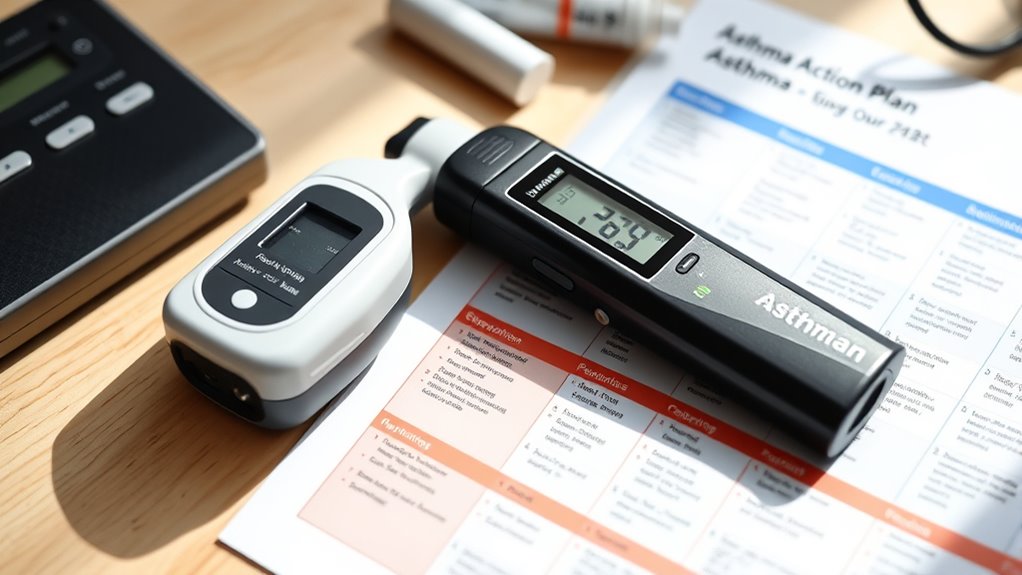
Monitoring your lung function through peak flow readings is a vital part of managing asthma effectively. By regularly checking your peak flow, you get a clear picture of how well your lungs are functioning on any given day. To do this, you’ll need a peak flow meter, which is easy to use. Stand up straight, take a deep breath, and blow into the device as hard and fast as you can. Record your reading, then repeat three times, noting the highest number. Tracking these readings over time helps you notice patterns or gradual declines in your lung function. This information empowers you to take timely action, adjust your medication if needed, and prevent an asthma attack. Consistent monitoring keeps you in control of your asthma.
Recognizing Early Warning Signs of an Asthma Attack

You need to be alert for early signs of an asthma attack, such as changes in your breathing pattern or increased chest tightness. Coughing and wheezing can also signal that your symptoms are worsening. Recognizing these warning signs early helps you take action before things get serious. Being aware of asthma triggers can help you prevent attacks before they start.
Breathing Pattern Changes
Have you noticed your breathing becoming more shallow or labored? This is a key sign that your asthma may be worsening. Changes in your breathing pattern, like faster breaths or difficulty catching your breath, can signal an impending attack. Pay close attention to these signs, especially if they appear suddenly. Use this table to help identify early warning signs:
| Sign | What to Do | When to Seek Help |
|---|---|---|
| Increased breathing rate | Use your inhaler or medication | If it doesn’t improve quickly |
| Shortness of breath | Rest and stay calm | If it worsens or persists |
| Using accessory muscles | Sit upright, avoid exertion | When symptoms are severe |
| Whistling or wheezing | Monitor and follow your plan | If it becomes loud or persistent |
Early detection helps prevent a full-blown attack. Stay alert to these changes. Recognizing early signs aligns with the importance of knowledge and learning from ancient wisdom, which emphasizes awareness and understanding as key to effective action.
Chest Tightness Signals
Chest tightness is a common early warning sign that your asthma may be worsening, signaling that inflammation and constriction are increasing in your airways. You might feel a squeezing or pressure sensation across your chest, making it harder to breathe comfortably. This sensation often occurs before other symptoms like coughing or wheezing develop, so recognizing it early is essential. If you notice this tightness, don’t ignore it—take action as your asthma could be progressing. You may also feel a sense of heaviness or fullness, which can cause anxiety or panic. Monitoring these signals helps you decide when to use your quick-relief inhaler or seek medical help. Being alert to chest tightness helps prevent a full-blown attack and keeps your asthma under better control. Additionally, understanding AI safety measures and staying informed about potential vulnerabilities in medical devices can help ensure your asthma management tools remain reliable.
Cough and Wheezing
Coughing and wheezing often appear as early signs that your asthma is worsening, signaling that inflammation and narrowing of the airways are progressing. You might notice a persistent cough that won’t go away or a wheezing sound when you breathe, especially at night or during physical activity. These symptoms can indicate that your airways are becoming more inflamed and restricted. It’s important to pay attention to these signs and not ignore them. Using your rescue inhaler can help relieve symptoms temporarily, but if coughing and wheezing continue or worsen, you should take action according to your asthma plan. Recognizing these early warning signs allows you to adjust your medication and seek medical advice promptly, helping prevent a full-blown attack. Being aware of asthma triggers can also help you avoid situations that might worsen your symptoms.
Developing Your Personal Medication Schedule

Creating a personalized medication schedule guarantees you take your asthma medicines consistently and effectively. To develop one, consider these steps: 1. Identify your medications—know which are daily controllers and which are quick-relief inhalers. 2. Set specific times—take your medicines at the same times each day to build a routine. 3. Use reminders—set alarms or phone alerts to ensure you don’t forget doses. 4. Track your usage—keep a medication journal to monitor adherence and identify patterns. Additionally, storing medications properly can help maintain their effectiveness over time. This approach helps you stay on top of your treatment, prevents missed doses, and ensures your asthma remains controlled. Remember, a consistent schedule empowers you to manage symptoms proactively and reduces the risk of flare-ups.
Creating Action Steps Based on Symptom Severity
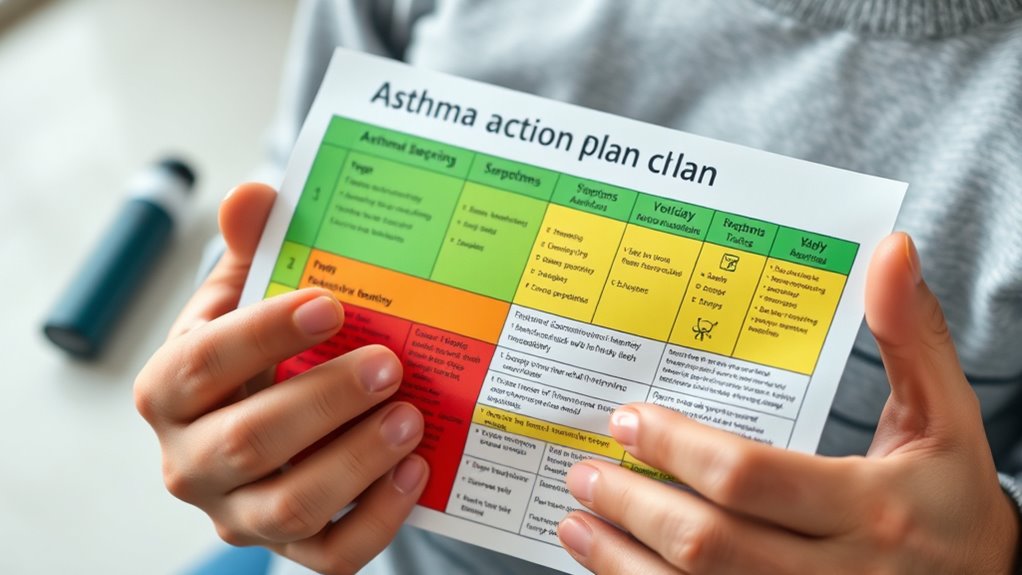
Understanding how to respond to your asthma symptoms requires establishing clear action steps based on their severity. By doing this, you can effectively manage your condition and prevent worsening symptoms. Start by categorizing your symptoms into mild, moderate, and severe. For mild symptoms, you might use your quick-relief inhaler and monitor your condition. Moderate symptoms may require additional medication and reducing activity. Severe symptoms need immediate action, like contacting your healthcare provider or following emergency protocols. Use this table as a guide:
| Symptom Severity | Action Steps | Medications Needed |
|---|---|---|
| Mild | Use inhaler, monitor | Quick-relief inhaler |
| Moderate | Inhaler + rest, reduce activity | Inhaler, controller meds |
| Severe | Seek medical help immediately | Emergency medication, call 911 |
It’s also important to recognize symptom severity early to adjust your response accordingly.
Emergency Response and When to Seek Immediate Help
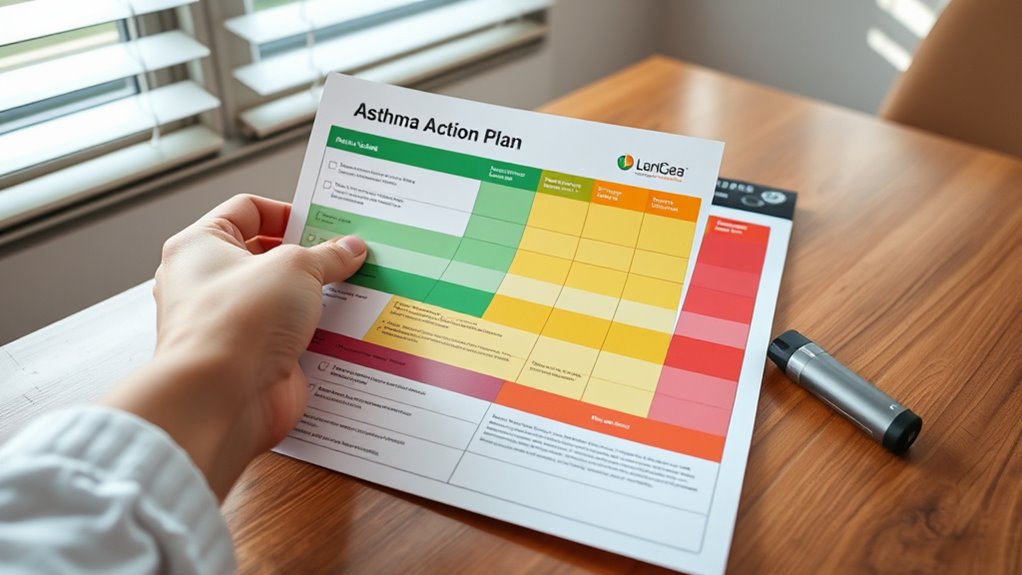
If you notice severe symptoms like blue lips, difficulty speaking, or extreme shortness of breath, it’s time to act immediately. Follow your emergency action steps, such as using your rescue inhaler and calling 911 if symptoms worsen. Recognizing these signs helps you get the urgent care you need without delay. Monitoring your symptom severity can help you determine when to seek emergency assistance.
Recognizing Severe Symptoms
Severe asthma symptoms require immediate action because they can quickly become life-threatening. Recognizing these signs early can save your life. Watch for:
- Severe shortness of breath that doesn’t improve after using your inhaler
- Chest tightness or pain that worsens
- Difficulty speaking or walking due to breathlessness
- Lips or face turning blue or gray
- Trust your instincts; if your symptoms escalate quickly or feel worse despite medication, call emergency services immediately. Staying alert and acting promptly can prevent serious complications and keep you safe. Always follow your asthma action plan for guidance on when to seek urgent care.
Emergency Action Steps
When your asthma symptoms suddenly worsen or reach a critical level, taking swift action can make all the difference. Know when to seek emergency help immediately. If you experience severe difficulty breathing, bluish lips or face, or cannot speak more than a few words, call 911 right away. While waiting for help, stay calm, sit upright, and use your rescue inhaler as prescribed. Remember, timely action can prevent a life-threatening situation. Recognizing early signs of worsening asthma can help you respond more effectively preventive measures.
Communicating Your Asthma Plan to Family and Caregivers
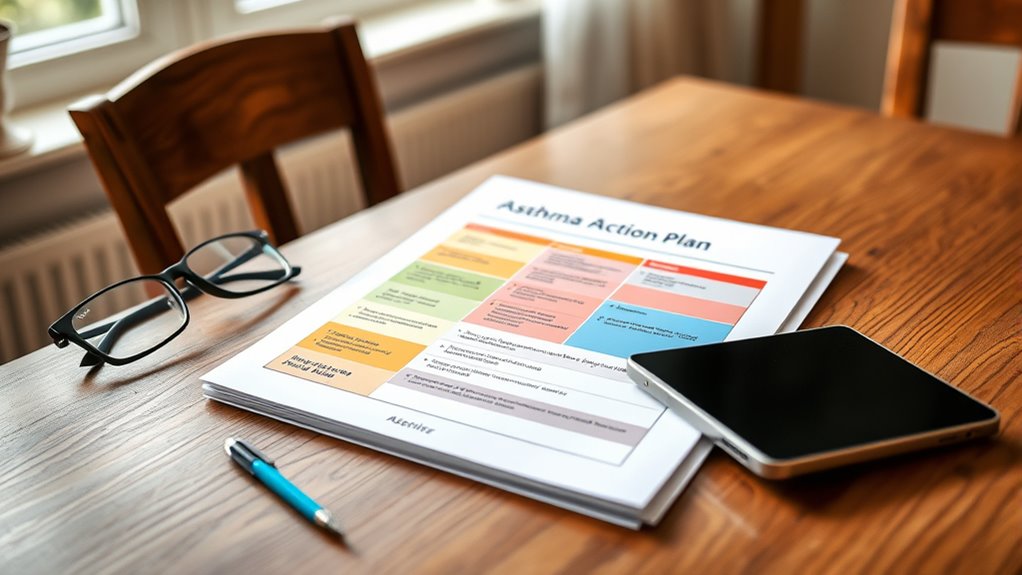
Have you shared your asthma action plan with your family and caregivers? Clear communication is key to managing your condition effectively. Here’s how to make certain they understand and can support you:
- Explain your symptoms and triggers so they recognize early warning signs.
- Show them the specific steps to take during an attack or worsening symptoms.
- Provide a list of your emergency contacts and nearby medical facilities.
- Practice role-playing scenarios to boost their confidence in helping you.
Regular Review and Updating of Your Asthma Action Plan

Regularly reviewing and updating your asthma action plan guarantees it remains effective and tailored to your current condition. As your asthma can change over time, what worked yesterday might not be enough today. Set a routine, such as every few months or after any asthma flare-up, to go over your plan. Check if your symptoms have changed or if your medications need adjustments. Make sure your emergency contacts are current, and your action steps still match your current health status. Keeping your plan up-to-date helps you respond quickly and confidently to any asthma symptoms. It also ensures your healthcare provider is aware of your latest condition, making future treatment more effective. Regular reviews empower you to stay in control of your asthma.
Tips for Maintaining Long-Term Asthma Control
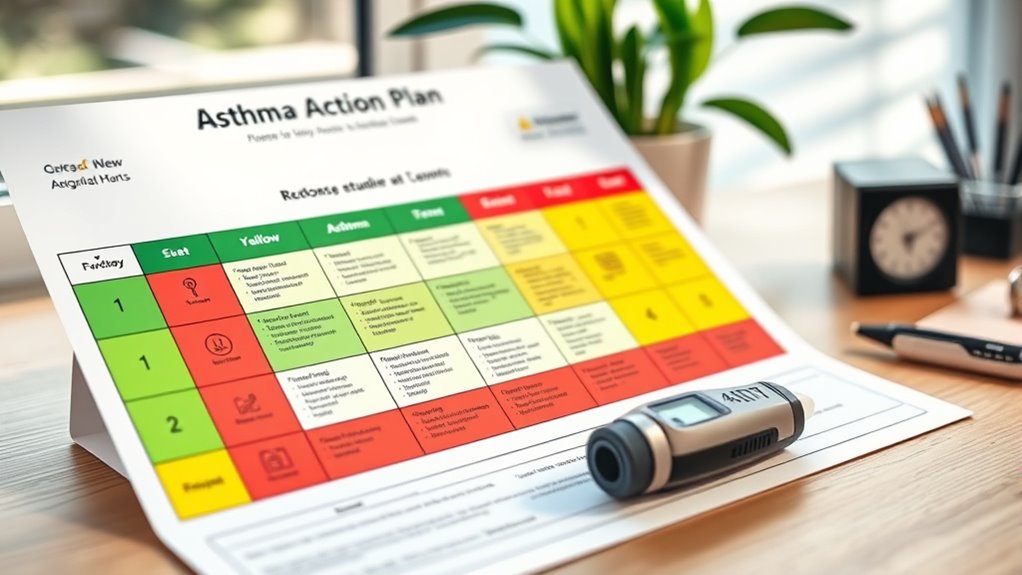
Maintaining long-term asthma control requires consistent habits and proactive management. To stay on top of your condition, consider these tips:
- Follow your prescribed medication plan diligently.
- Monitor your symptoms daily and keep track of any changes.
- Identify and avoid triggers that worsen your asthma.
- Schedule regular check-ups with your healthcare provider.
Sticking to these steps helps you catch issues early, prevent flare-ups, and maintain a better quality of life. Remember, managing asthma isn’t a one-time effort; it’s an ongoing process. By staying vigilant and committed, you empower yourself to control your symptoms and reduce the risk of emergencies. Consistency is key—make these habits part of your daily routine for long-term success.
Frequently Asked Questions
How Often Should I Review My Asthma Action Plan?
You should review your asthma action plan regularly to stay on top of your condition. It’s best to do this at least every 3 to 6 months, or whenever your symptoms change. Make sure to update it after doctor visits or if your medication needs change. Regular reviews help you recognize warning signs early and adjust your plan accordingly, keeping your asthma under control and reducing the risk of attacks.
Can Lifestyle Changes Improve My Asthma Control?
Imagine reducing your asthma attacks by simply quitting smoking—lifestyle changes can markedly improve your control. You can lessen symptoms and prevent flare-ups by avoiding triggers, maintaining a healthy weight, and staying active. These adjustments strengthen your lungs and boost your overall health. Small changes, like managing stress or improving your diet, make a big difference in controlling asthma, helping you breathe easier and live better every day.
What Should I Do if My Symptoms Worsen Unexpectedly?
If your symptoms worsen unexpectedly, you should act quickly. Take your rescue inhaler as prescribed and sit down calmly. Avoid triggers that might worsen your condition. If your symptoms don’t improve within 15 minutes, or if they get worse, seek emergency medical help immediately. Keep your Asthma Action Plan accessible, so you know when to escalate your treatment or get urgent care. Don’t ignore worsening symptoms—prompt action can prevent serious complications.
Are There Any New Treatments for Adult Asthma Management?
While new treatments for adult asthma are emerging, your best approach remains working closely with your doctor to customize your management plan. You might consider options like biologic therapies, which target specific immune responses, or updated inhalers with fewer side effects. These innovations can improve control and reduce flare-ups. Stay informed about research, but always consult your healthcare provider before making changes to guarantee they fit your specific condition.
How Can I Prevent Asthma Attacks During Exercise?
During exercise, you can prevent asthma attacks by warming up gradually, which prepares your lungs. Use your prescribed inhaler, like a rescue inhaler, before starting activity if recommended by your doctor. Avoid exercising in cold, dry air, and try to breathe through your nose to warm and humidify the air. Staying consistent with your asthma management plan and monitoring symptoms helps reduce the risk of attacks during physical activity.
Conclusion
By understanding your triggers, monitoring your symptoms, and following your personalized action plan, you take control of your asthma. Regular check-ins and open communication guarantee you’re prepared for any situation. Remember, isn’t your health worth the effort? Staying proactive keeps your lungs healthy and your life full of activity. Take charge today—your future self will thank you for the peace of mind and confidence you gain.









